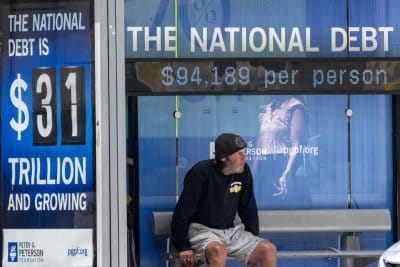Sell-offs resume on Wall Street as Moody’s downgrades US credit rating
Following a broad weekly rally on Wall Street amid a de-escalation in the US-China trade war, risk-off sentiment once again prevailed in global markets following a major downgrade of US credit ratings by Moody’s. Global equity indices fell during Monday’s Asian session as sell-offs in US assets resumed, with US stock futures, the dollar, and government bonds all declining.
Moody’s downgrades US credit ratings
On Friday, Moody’s Ratings, a major American credit rating agency, downgraded the “US long-term issuer and senior unsecured ratings” to Aa1 from the top-tier Aaa due to mounting concerns over rising government debt and widening fiscal deficits.
The agency stated: “Over more than a decade, US federal debt has risen sharply due to continuous fiscal deficits. During that time, federal spending has increased while tax cuts have reduced government revenues. As deficits and debt have grown, and interest rates have risen, interest payments on government debt have increased markedly.”
Moody’s downgrade followed similar moves by rival agencies: Standard & Poor’s cut its US sovereign credit rating to AA+ in 2011, and Fitch Ratings made the same downgrade in 2023.
The decision led to a rise in US government bond yields as investors demanded a higher premium to compensate for perceived risks. The 10-year Treasury yield rose by 5 basis points (1 basis point = 0.01 percentage point) to 4.48% on Friday, climbing further to 4.51% during Monday’s Asian session. The downgrade also appeared to dampen investor appetite for other US assets, including equities and the dollar.
Moody’s expects federal budget flexibility to remain “limited” without adjustments to taxation and government spending. The agency projected that the US deficit would expand by approximately $4 trillion (€3.58 trillion) over the next decade if the 2017 Tax Cuts and Jobs Act is extended. “Federal interest payments are likely to absorb around 30% of revenue by 2035, up from about 18% in 2024 and 9% in 2021,” Moody’s added.
“It does speak to a level of market risk in US debt, which is to say that the value of US bonds could be compromised if the economy can no longer run at the growth rates necessary to service the government’s liabilities,” Kyle Rodda, senior market analyst at Capital.com in Australia, said.
Risk-off sentiment prevails
US equity futures fell sharply during Monday’s Asian session following Moody’s downgrade. As of 4:42 am CEST, futures on the Dow Jones Industrial Average were down 0.65%, the S&P 500 dropped 0.92%, and the Nasdaq Composite declined by 1.22%.
Asian equities also came under pressure amid the risk-off tone. Japan’s Nikkei 225 dropped 0.66%, Australia’s ASX 200 declined 0.46%, and Hong Kong’s Hang Seng Index slid 0.56% during the same period.
The ripple effect is expected to spill into European markets, though major indices such as the Euro Stoxx 600 and the DAX were set to open flat.
The US dollar also weakened against other G10 currencies, particularly safe-haven currencies including the euro, the Japanese yen, and the Swiss franc. Gold prices rose amid increased haven demand, although the yellow metal pulled back from an intraday high, likely due to pressure from rising US bond yields. Gold futures initially surged over 1% before retreating and were 0.8% higher, trading at $3,213 per ounce as of 4:12 am CEST.
Despite market jitters, Rodda believes the impact of Moody’s move will be short-lived. “I don’t think it will have a lasting impact,” he said, although he views the downgrade as “a reminder of the very loose fiscal policy the US is running and the structural problems related to US public finance.”


